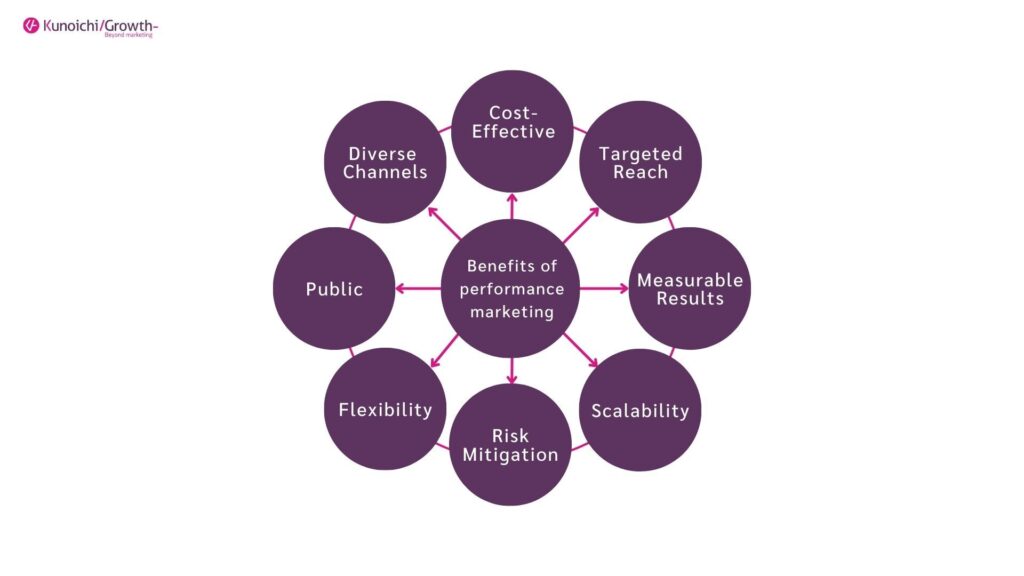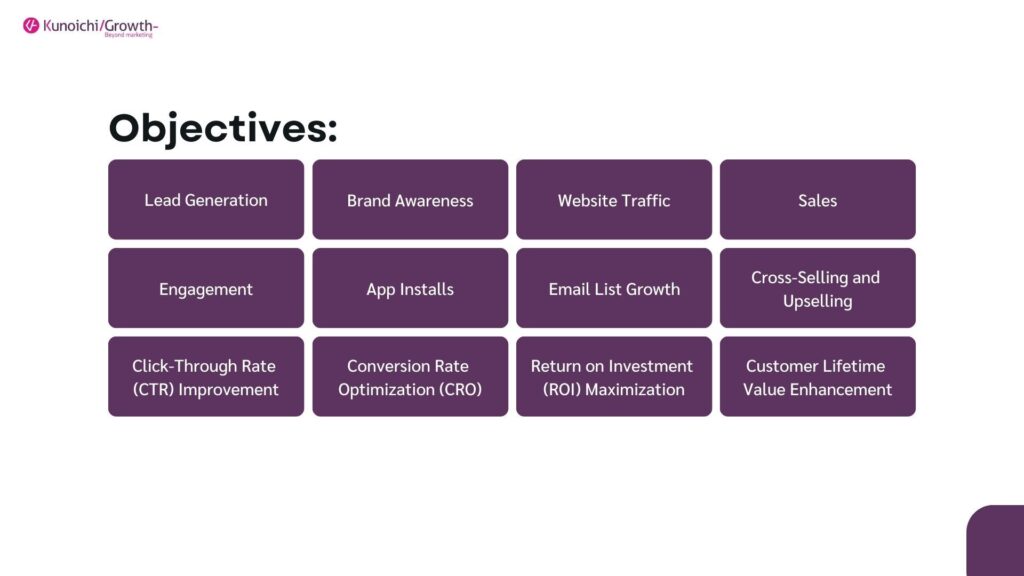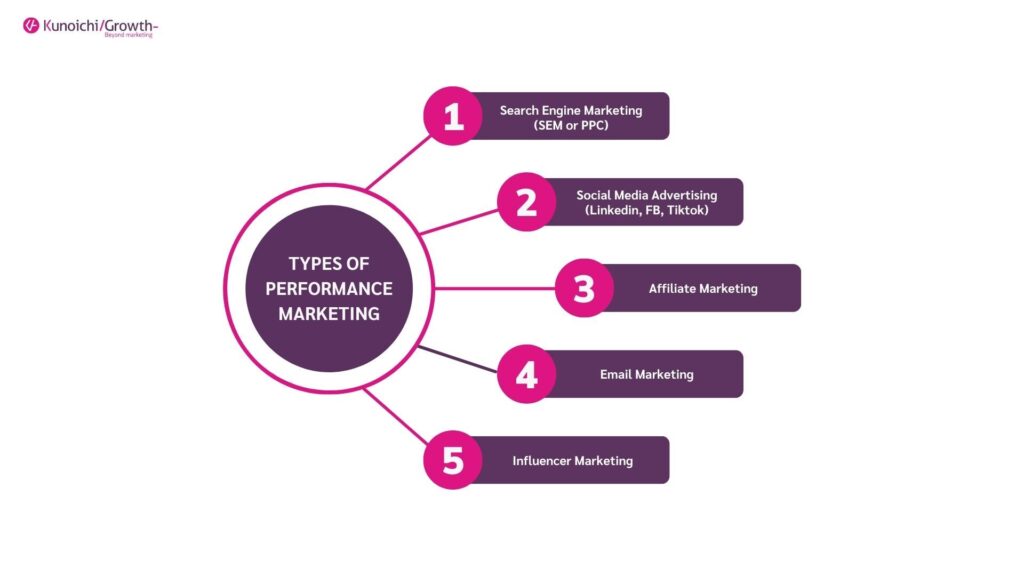In our fast-paced digital age, traditional marketing tactics often fall short in capturing the attention of discerning B2B decision-makers. So many decision-makers. So many people to convince. Ugh!
With CEOs, CMOs and marketing directors being bombarded with an overwhelming amount of information, reaching them in a meaningful way has become an art in itself. You need a strategy that not only engages your audience but also guides them seamlessly through the buyer’s journey, converting them into loyal customers.
This is where performance marketing steps in as the ultimate solution for B2B companies. Think of it as the secret ingredient to your marketing success. If I have to explain it in simple language, it’s like that perfectly brewed cup of coffee that jumpstarts your day and keeps you going (even during those long, never-ending meetings).
Unlike conventional marketing approaches that rely on guesswork, performance marketing is data-driven and result-oriented. Kind of a GPS for your marketing campaigns, you always know what path will take you to your ultimate destination.
As the driving force behind my agency- Kunoichi Growth, I have witnessed firsthand how performance marketing empowers businesses like yours to generate leads and acquire customers. With a laser focus on the specific needs of B2B businesses, our performance marketing agency has honed its expertise in devising and executing strategies that resonate with businesses alike. We understand the importance of crafting messages that speak directly to your target audience, addressing their pain points, and providing valuable solutions. Because, let’s face it, nobody has time for generic, one-size-fits-all marketing fluff.
In this blog, we will share our step-by-step approach to launching a successful performance marketing campaign tailored explicitly for B2B businesses. Whether your goal is to attract high-quality leads, nurture prospects through the sales funnel, or boost conversions, we have got your back.
By the end of this blog, you will have a clear roadmap that aligns with your business objectives, allowing you to leverage performance marketing as a powerful tool in your arsenal.
So, let’s buckle up, fuel up with some coffee (or your preferred caffeinated beverage), and get ready for an exhilarating journey into the path of performance marketing.

Step-By-Step Guide To Creating A Successful Paid Marketing Strategy
As a business owner, you know that marketing is essential for driving growth and generating leads. But with so many options out there, it can’t be easy to know where to start. Discover now how to start!
Why performance marketing?
First thing first, you might wonder, what makes performance marketing so special? Why are companies, large or small, turning their focus towards this strategy, or even seeking out specialized performance marketing agencies to propel their growth?
The answer lies in the distinctive advantages that performance marketing brings to the table, setting it apart from traditional marketing methods.
Unlike conventional marketing, which often involves hefty upfront expenses and ambiguous returns on investment, performance marketing flips the script entirely. It operates on the principle of paying for tangible results, meaning businesses only shell out their marketing budget when desired actions are achieved.
Whether it’s clicks, leads, conversions, or sales, performance marketing empowers businesses to track and measure the exact outcomes of their campaigns with pinpoint precision. This level of transparency not only instils confidence in businesses but also enables them to fine-tune their strategies based on real-time data and insights, maximizing efficiency and driving impressive returns.

And it doesn’t stop there. Traditional marketing approaches often cast a wide net, hoping to catch potential customers in the process. However, performance marketing is laser-focused, targeting specific audiences with tailored messages, ensuring that the right people receive the right content at the right time.
This personalized touch fosters meaningful connections between businesses and their customers, leading to more engagement, stronger brand loyalty and higher conversion. So, let’s break down the process of building a powerful performance marketing strategy, step by step.
Step 1: Setting Clear Objectives
Before diving into any marketing campaign, it’s crucial to establish clear and realistic objectives. As a CEO, CMO or marketing director of a B2B company, you’re probably no stranger to setting goals for your business. However, when it comes to performance marketing, your objectives need to be specific, measurable, achievable, relevant, and time-bound (SMART).
Let’s take a closer look at how this plays out in practice. You might set an objective to increase the number of qualified leads coming into your sales funnel by 30% within the next quarter. This objective is specific, as it focuses on a particular metric (qualified leads) and is measurable (30% increase).
It’s also achievable, given your current resources and market conditions. Additionally, increasing qualified leads is highly relevant to your business as it directly impacts revenue generation. Lastly, setting a timeframe of one quarter makes the objective time-bound, providing a sense of urgency and focus.
Another objective could be to improve your website’s conversion rates for a specific landing page. Let’s say you aim to increase the conversion rate from 5% to 8% within two months. By doing so, you create a specific target (conversion rate improvement), and it’s measurable as you have baseline data (5% conversion rate). The goal is also achievable with the right optimizations, relevant to your marketing efforts, and time-bound, giving your team a clear timeline to work towards.
When setting objectives, consider both short-term and long-term goals. Short-term objectives provide quick wins and keep your team motivated, while long-term objectives help you stay focused on the bigger picture and the overall growth trajectory of your B2B business.

Always, ALWAYS, keep in mind that performance marketing thrives on data-driven decision-making. Ensure you have the necessary analytics tools in place to track and measure the performance of your campaigns. This will enable you to assess the success of your objectives accurately and make informed adjustments along the way.
Once your objectives are in place, communicate them clearly to your team and any external partners, such as your performance marketing agency. Everyone involved needs to be on the same page to align efforts and work collaboratively towards achieving your goals.
Step 2: Identifying Your Target Audience
I know you already know this. Understanding your target audience is paramount to successful marketing. However, in the world of performance marketing, it’s not just about knowing who your audience is but understanding them at a deeper level.
Start by creating a detailed Ideal Customer Profile (ICP). Look at your existing customer base and identify the clients who bring the most value to your business. Consider factors such as company size, industry, location, pain points, desires, difficulties and interests. Are there any patterns or common characteristics among your top-performing clients? Are they struggling with the same problem? This exercise will help you craft a clear picture of your ideal customer, allowing you to tailor your marketing messages to suit their specific needs.
For instance, if you’re a SaaS company targeting B2B clients, your ICP might include mid-sized technology firms in the healthcare industry. Understanding the unique challenges faced by these companies will help you create content and campaigns that directly address their pain points and offer solutions.
Once you have your ICP, take it a step further by creating detailed buyer personas. Buyer personas are fictional representations of your ideal customers, delving into their motivations, goals, challenges, and buying behaviour. Give each persona a name and background, making them feel like real people. The more you humanize your target audience, the better you can connect with them on a personal level.
Let’s say you offer a marketing automation tool. One of your buyer personas might be “Tech-Savvy Jessica,” a CMO of a fast-growing tech company. Jessica is constantly looking for innovative tools to streamline her team’s marketing efforts and achieve better ROI. By understanding Jessica’s pain points and aspirations, you can create content and marketing campaigns that directly address her needs and showcase how your product can solve her specific challenges.
There is also a hidden treasure that you can use to understand buyer behaviour. In the digital age, customers leave a trail of valuable data through their interactions with your brand. Dive into your website analytics, social media insights, and customer feedback to gain insights into their preferences and behaviours.
Pay close attention to the content and topics that resonate the most with your audience. Are there any recurring themes in their inquiries or comments? This information will guide your marketing strategy, ensuring that you provide valuable and relevant information that keeps your audience engaged.
By identifying your target audience with precision, you can create marketing campaigns that hit the mark and resonate deeply with the decision-makers of other B2B companies. Understanding their pain points, motivations, and preferences will enable you to craft personalized messages that establish your brand as a trusted authority in your industry.
Step 3: Selecting the Right Resources and Channels
If your B2B company has an in-house marketing team, you already have a valuable asset at your disposal. Your team members possess an intimate knowledge of your brand, industry, and target audience, which can be leveraged to execute performance marketing campaigns effectively. However, it’s essential to optimize their efforts to ensure maximum impact and ROI.
The first step in harnessing the potential of your in-house marketing team is ensuring strong collaboration and alignment with your overall business objectives. As a CEO, CMO, or marketing director, provide your team with a clear understanding of the company’s vision, goals, and target audience. By having everyone on the same page, your in-house marketers can develop performance marketing strategies that align seamlessly with your broader business strategy.
Just keep one thing in mind, data is and should be the backbone of performance marketing success. Ensure your in-house team has access to robust analytics tools and insights. This enables them to analyze key performance metrics, identify areas for improvement, and make data-driven decisions. Regular data reviews and performance evaluations will help your team optimize their campaigns and achieve your performance marketing objectives efficiently.
If you don’t have an in-house marketing team, hiring a performance marketing agency is the best thing that you can do. When your B2B company decides to partner with a performance marketing agency, you gain access to a specialized team of experts dedicated to driving your marketing success.
Performance marketing agencies have extensive experience across various industries and clients. By tapping into their industry expertise, you gain fresh perspectives and insights into successful marketing strategies that have worked for similar B2B businesses. Whether it’s crafting compelling ad copy, optimizing conversion rates, or designing engaging content, the agency’s specialists have honed their skills to deliver excellence in each area. By capitalizing on their expertise, you can implement comprehensive, multi-channel campaigns that reach your target audience wherever they are online.
And here is the best part! You don’t need to invest heavily in a full in-house marketing team when you partner with a performance marketing agency like Kunoichi Growth. The agency can take care of campaign planning, execution, and optimization, allowing your in-house team to focus on other core business activities. Additionally, with access to advanced analytics tools and performance insights, the agency can efficiently allocate your marketing budget to channels that deliver the best return on investment.
All in all, performance marketing agencies offer scalability and flexibility. They have the resources to handle varying workloads and can quickly adjust strategies to capitalize on emerging opportunities. This adaptability ensures that your marketing efforts remain agile and effective in an ever-changing business environment.
Ultimately, whether you have an in-house marketing team or decide to collaborate with a performance marketing agency, the key lies in maximizing your resources and expertise. In-house teams can leverage their knowledge of your brand and industry, while an external agency brings specialized skills, diverse perspectives, and scalability to elevate your performance marketing efforts.
Step 4: Crafting a Tailored Performance Marketing Strategy
A successful performance marketing campaign requires a well-crafted strategy. Begin by selecting the most suitable marketing channels for your B2B business. These may include search engine marketing (SEM), social media platforms, email marketing, affiliate marketing or influencer marketing. Each channel serves a unique purpose, and integrating them strategically can yield impressive results.
If your primary goal is to capture potential customers actively searching for products or services like yours, Search Engine Marketing (SEM) is an excellent choice. Google’s search ads, display ads, and remarketing options allow you to reach prospects during the consideration phase of their buyer journey. By bidding on relevant keywords, your ads can appear at the top of search engine results, reaching potential customers who are actively searching for solutions that you offer.
For instance, if you’re a software-as-a-service (SaaS) provider catering to B2B clients in the finance sector, bidding on keywords like “financial software for businesses” or “B2B finance automation” can place your ads in front of decision-makers looking for solutions in this space. SEM or in other words, PPC ensures that your message reaches the right people at the right time, maximizing your chances of converting them into valuable leads.

Another good option is social media marketing. Social media platforms offer a vast landscape to connect with your B2B target audience. Platforms like LinkedIn, for example, are particularly valuable for reaching decision-makers and key stakeholders. With LinkedIn’s targeting options, you can narrow down your audience based on job titles, company size, industry, and other criteria.
Suppose your B2B company provides marketing automation solutions. In that case, you can use LinkedIn advertising to target decision-makers of technology companies, showcasing how your product can streamline their marketing efforts and boost efficiency. By presenting relevant content through social media advertising, you can establish your brand as an industry authority and build trust among decision-makers. Sponsored content, text ads, and dynamic ads on LinkedIn can help you engage with a highly targeted audience. You will be on their radar as soon as they open Linkedin. What else do you want?
When focusing on brand awareness and engaging prospects at the early stages of their buyer journey, Facebook and Instagram can be valuable platforms. These social media channels offer advanced targeting capabilities, allowing you to create customized audiences based on demographics, interests, and behaviors. Engaging visual content, video ads, and carousel ads can capture the attention of potential customers and drive them to explore your B2B offerings further. Based on the nature of your business, you can also use affiliate marketing, email marketing or influencer marketing to achieve your marketing goals.
Step 5: Implementing and Executing Your Performance Marketing Campaign
With a carefully crafted performance marketing strategy in hand, it’s time to roll up your sleeves and execute your campaign. This step is all about translating your plans into action and ensuring that your marketing efforts align seamlessly with your objectives.
Hang on tight as implementation has many different criteria that need to be satisfied. Let’s talk about them one by one.
– Landing Page Optimization
Your landing pages are the gateways to converting visitors into leads and customers. Ensure that your landing pages are optimized for maximum conversions. Keep the design clean, focused, and visually appealing. Use persuasive copy that clearly communicates the value of your offer and includes a strong call-to-action (CTA). Test different elements, such as headlines, CTA buttons, and form fields, to find the best-performing combination.
– Ad Creative and Copy
When crafting your ad creative and copy, remember the importance of relevance and consistency. Align your ad content with the messaging on your landing pages to create a seamless user experience. Use eye-catching visuals and compelling copy that resonates with your target audience’s pain points and aspirations. If your ad is boring, people are less likely to engage with it. A/B test different ad variations to identify what works best and refine your messaging for optimal engagement.
– Budget Allocation and Bidding Strategy
Effective budget allocation is crucial to maximize your return on investment. Distribute your budget across different marketing channels based on their performance and potential for reaching your target audience. In search engine marketing (SEM) and social media advertising, use an appropriate bidding strategy to optimize your ad placements while staying within your budget constraints.
– Marketing Automation and Nurturing
Marketing automation plays a vital role in nurturing leads and guiding them through the sales funnel. Implement marketing automation tools to automate email sequences, lead scoring, and personalized content delivery. Create nurture campaigns that deliver relevant content to leads at different stages of the buying process, addressing their specific pain points and concerns.
– Real-Time Monitoring and Optimization
The success of your performance marketing campaign hinges on continuous monitoring and optimization. Never forget, in life and marketing, there is always room for improvement. Keep a close eye on key performance metrics and make real-time adjustments as needed. Use analytics tools to track conversions, click-through rates, and other KPIs.
If you don’t know what metrics to track to measure the success of your marketing campaign, give this blog a good read. It has all the metrics and KPIs (with formulas) that you should track to gauge how well your marketing campaigns are performing. Identify underperforming elements and optimize them to improve your campaign’s overall performance.
– Performance Reporting
Regularly provide performance reports to stakeholders, including your team and company leadership. These reports should include key metrics, insights, and progress towards your objectives. Transparent reporting fosters collaboration and alignment among team members. Importantly, it showcases the impact of your performance marketing efforts on the company’s bottom line.
– A/B Testing and Iterative Refinement
Never stop testing and refining your performance marketing strategies. A/B test various elements, such as ad copy, visuals, landing pages, and audience targeting, to identify the most effective combinations. Use the insights gained from testing to make iterative improvements to your campaigns continuously.





